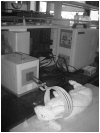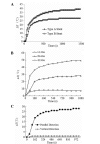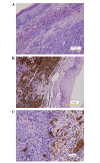Local hyperthermia for esophageal cancer in a rabbit tumor model: Magnetic stent hyperthermia versus magnetic fluid hyperthermia
- PMID: 24260045
- PMCID: PMC3833863
- DOI: 10.3892/ol.2013.1618
Local hyperthermia for esophageal cancer in a rabbit tumor model: Magnetic stent hyperthermia versus magnetic fluid hyperthermia
Abstract
Magnetic-mediated hyperthermia (MMH) is a promising local thermotherapy approach for cancer treatment. The present study investigated the feasibility and effectiveness of MMH in esophageal cancer using a rabbit tumor model. The therapeutic effect of two hyperthermia approaches, magnetic stent hyperthermia (MSH), in which heat is induced by the clinical stent that is placed inside the esophagus, and magnetic fluid hyperthermia (MFH), where magnetic nanoparticles are applied as the agent, was systematically evaluated. A rabbit esophageal tumor model was established by injecting VX2 carcinoma cells into the esophageal submucosa. The esophageal stent was deployed perorally into the tumor segment of the esophagus. For the MFH, magnetic nanoparticles (MNPs) were administered to the rabbits by intratumoral injection. The rabbits were exposed under a benchtop applicator using an alternative magnetic field (AMF) with 300 kHz frequency for the hyperthermia treatment. The results demonstrated that esophageal stents and MNPs had ideal inductive heating properties upon exposure under an AMF of 300 kHz. MSH, using a thermal dose of 46°C with a 10-min treatment time, demonstrated antitumor effects on the rabbit esophageal cancer. However, the rabbit esophageal wall is not heat-resistant. Therefore, a higher temperature or longer treatment time may lead to necrosis of the rabbit esophagus. MFH has a significant antitumor effect by confining the heat within the tumor site without damaging the adjacent normal tissues. The present study indicates that the two hyperthermia procedures have therapeutic effects on esophageal cancer, and that MFH may be more specific than MSH in terms of temperature control during the treatment.
Keywords: alternative magnetic field; esophageal cancer; esophageal stent; magnetic mediated hyperthermia; magnetic nanoparticles.
Figures













Similar articles
-
Magnetic stent hyperthermia for esophageal cancer: an in vitro investigation in the ECA-109 cell line.Oncol Rep. 2012 Mar;27(3):791-7. doi: 10.3892/or.2011.1603. Epub 2011 Dec 21. Oncol Rep. 2012. PMID: 22200741
-
In vitro study on the feasibility of magnetic stent hyperthermia for the treatment of cardiovascular restenosis.Exp Ther Med. 2013 Aug;6(2):347-354. doi: 10.3892/etm.2013.1177. Epub 2013 Jun 21. Exp Ther Med. 2013. PMID: 24137187 Free PMC article.
-
In vitro investigation on the magnetic thermochemotherapy mediated by magnetic nanoparticles combined with methotrexate for breast cancer treatment.J Nanosci Nanotechnol. 2013 Feb;13(2):741-5. doi: 10.1166/jnn.2013.6080. J Nanosci Nanotechnol. 2013. PMID: 23646507
-
Cytotoxic evaluation of pure and doped iron oxide nanoparticles on cancer cells: a magnetic fluid hyperthermia perspective.Nanotoxicology. 2024 Aug;18(5):464-478. doi: 10.1080/17435390.2024.2386019. Epub 2024 Aug 2. Nanotoxicology. 2024. PMID: 39091195 Review.
-
Combining magnetic particle imaging and magnetic fluid hyperthermia for localized and image-guided treatment.Int J Hyperthermia. 2020 Dec;37(3):141-154. doi: 10.1080/02656736.2020.1853252. Int J Hyperthermia. 2020. PMID: 33426994 Review.
Cited by
-
Nanomedicine and Hyperthermia for the Treatment of Gastrointestinal Cancer: A Systematic Review.Pharmaceutics. 2023 Jul 15;15(7):1958. doi: 10.3390/pharmaceutics15071958. Pharmaceutics. 2023. PMID: 37514144 Free PMC article. Review.
-
Percutaneous ultrasound guided implantation of VX2 for creation of a rabbit hepatic tumor model.PLoS One. 2015 Apr 8;10(4):e0123888. doi: 10.1371/journal.pone.0123888. eCollection 2015. PLoS One. 2015. PMID: 25853660 Free PMC article.
-
Functionalized Non-vascular Nitinol Stent via Electropolymerized Polydopamine Thin Film Coating Loaded with Bortezomib Adjunct to Hyperthermia Therapy.Sci Rep. 2017 Aug 25;7(1):9432. doi: 10.1038/s41598-017-08833-x. Sci Rep. 2017. PMID: 28842557 Free PMC article.
-
ROS-induced HepG2 cell death from hyperthermia using magnetic hydroxyapatite nanoparticles.Nanotechnology. 2018 Sep 14;29(37):375101. doi: 10.1088/1361-6528/aacda1. Epub 2018 Jun 19. Nanotechnology. 2018. PMID: 29920184 Free PMC article.
-
Regional thermochemotherapy versus hepatic arterial infusion chemotherapy for palliative treatment of advanced hilar cholangiocarcinoma: a retrospective controlled study.Eur Radiol. 2016 Oct;26(10):3500-9. doi: 10.1007/s00330-016-4208-7. Epub 2016 Jan 28. Eur Radiol. 2016. PMID: 26822373
References
-
- Jemal A, Center MM, DeSantis C, Ward EM. Global patterns of cancer incidence and mortality rates and trends. Cancer Epidemiol Biomarkers Prev. 2010;19:1893–1907. - PubMed
-
- Guo P, Li K. Trends in esophageal cancer mortality in China during 1987–2009: age, period and birth cohort analyzes. Cancer Epidemiol. 2012;36:99–105. - PubMed
-
- Corti L, Skarlatos J, Boso C, et al. Outcome of patients receiving photodynamic therapy for early esophageal cancer. Int J Radiat Oncol Biol Phys. 2000;47:419–24. - PubMed
-
- Tew WP, Kelsen DP, Ilson DH. Targeted therapies for esophageal cancer. Oncologist. 2005;10:590–601. - PubMed
-
- McCann P, Stafinski T, Wong C, Menon D. The safety and effectiveness of endoscopic and non-endoscopic approaches to the management of early esophageal cancer: A systematic review. Cancer Treat Rev. 2011;37:11–62. - PubMed
LinkOut - more resources
Full Text Sources
Other Literature Sources
Research Materials
Miscellaneous
